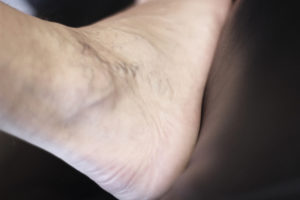Another Look at Skin and Your Veins
- Posted on: Sep 30 2017

What are venous ulcers?
Venous ulcers come in a variety of types. What doctors most commonly see are venous stasis ulcers. Our previous post discusses details of venous stasis dermatitis, a precursor to venous ulcers. Both conditions appear to be dermatologic. However, the underlying factor is an insufficiency in vein function. When the valves in the lower legs do not adequately push blood upward, the pooling of fluid in the ankles and feet cause an increase in pressure within blood vessels. Venous dermatitis and ulcers are the byproducts of this restriction in blood flow.
It is natural to think of blood flow as a method of oxygenating cells throughout the body. There’s more to circulation than that. Blood is integral to the exchange of nutrients within cells and organs. Blood that pools are devoid of necessary nutrients. When this product stagnates in the vessels of the feet and legs, there is a high risk for damage to surrounding tissue.
Symptoms of Venous Ulcers
A venous ulcer would seem like a problem that would be easy to spot. Often, early indications of this problem are mistaken as a bug bite. A key sign that differentiates the two is the longevity of a wound. A spider bite, for instance, is likely to cause temporary irritation such as a brown halo around a central bite. A venous ulcer, on the other hand, will persist, and may even worsen, the longer it is present without appropriate treatment.
Treating Venous Ulcers
Proper diagnosis and treatment are necessary for venous ulcers to improve. A common method of treatment involves compression due to the support veins receive from the elasticity of therapeutic compression stockings. When venous ulcers are advanced and weeping or oozing, multi-layer bandages may be necessary to absorb moisture simultaneous to compressing weakened veins.
The conditions that arise secondary to venous insufficiencies, such as venous ulcers, have the potential to cause irreparable damage to tissue. Early care for vein conditions may prevent severe progression of injury.
Schedule a Consultation
Learn more about vein treatments from Vena Health & Wellness. Contact us today at 412-741-0480.
Posted in: Vein Health
